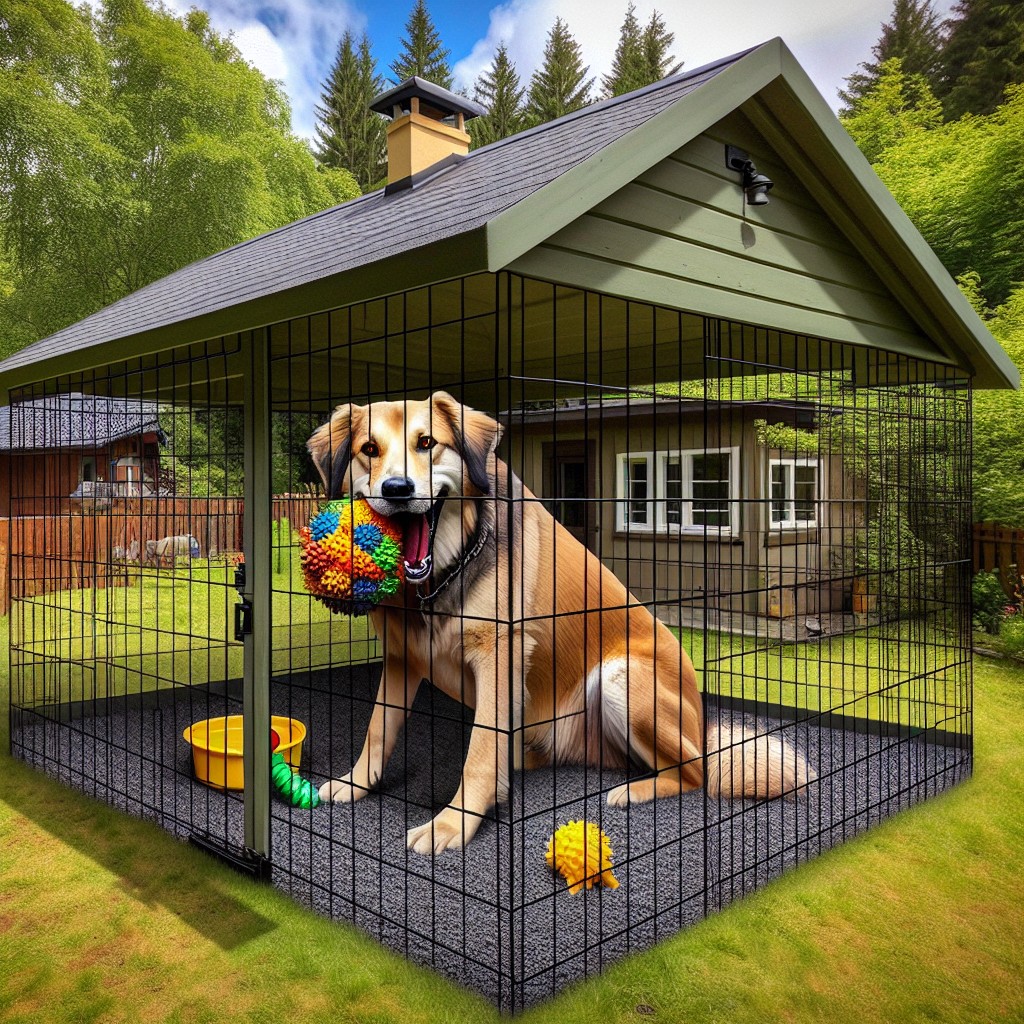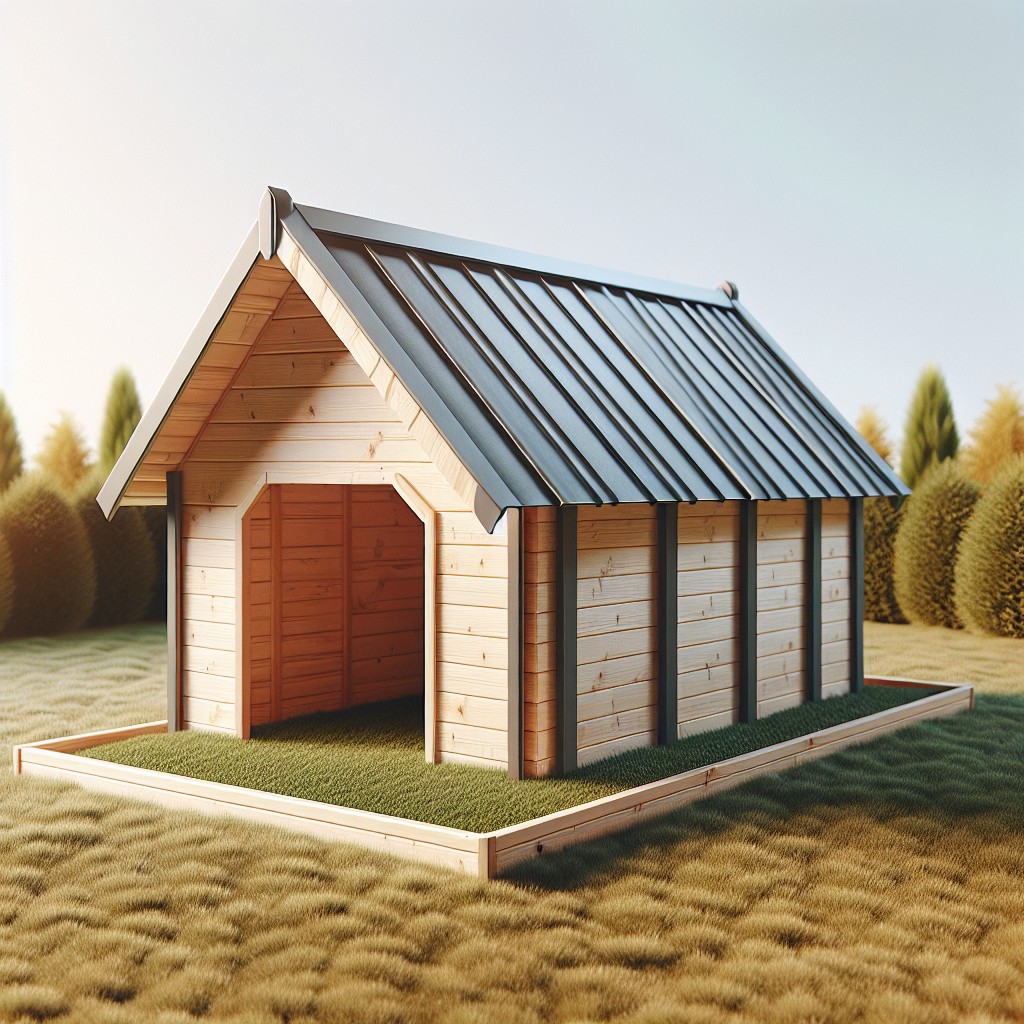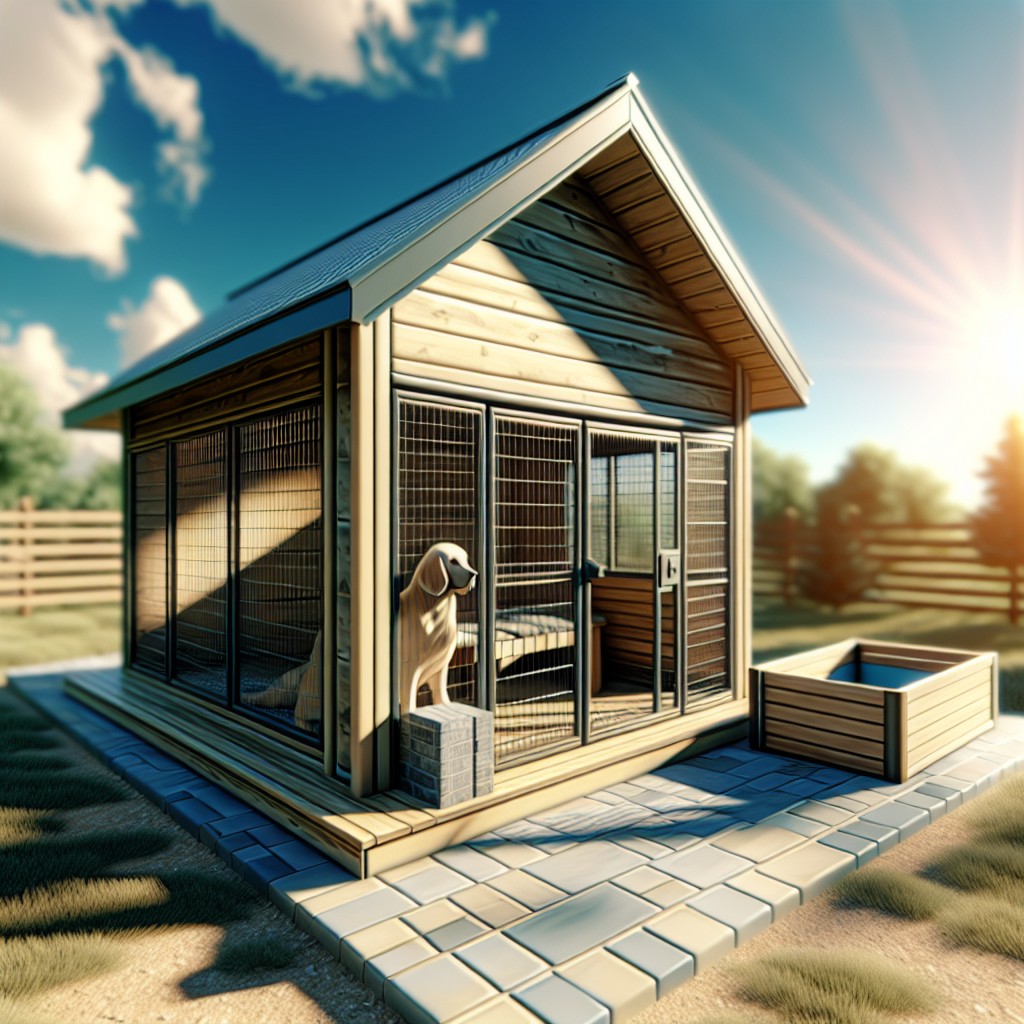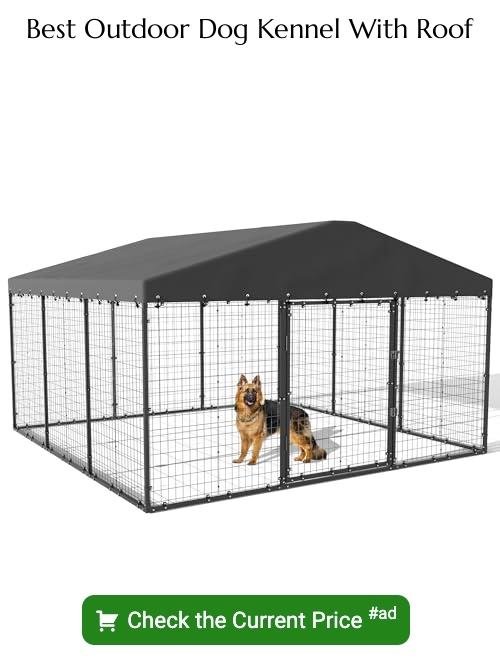Last updated on
Dive right into the myriad benefits of an outdoor dog kennel with a roof because it’s not just a luxury, but a handy and practical solution to keeping your canine companion safe and comfortable in all weather conditions.
Protecting your furry friend from the elements is crucial for their comfort and safety, which is where a roofed outdoor dog kennel comes into play. Whether shielding them from the blazing sun, pouring rain, or gusty winds, the right roof can make all the difference in the world.
From classic pitched designs to sturdy flat and elegant gable roofs, the options cater to varied aesthetic and functional needs. But it’s not just about the shape; the materials—be it durable metal, traditional asphalt shingles, natural wood, resilient plastic, or lightweight fabric—affect longevity and suitability for your specific climate conditions.
Moreover, understanding the importance of temperature regulation and the necessities of regular maintenance will ensure a hospitable haven for your canine companion. This article delves into the specifics, providing you with all the details you need to create a safe and enduring rooftop for your outdoor dog kennel.
Key takeaways:
- A roofed outdoor dog kennel provides protection from harsh weather.
- Different types of roofs are available, including pitched, flat, and gable roofs.
- Metal, asphalt shingles, wood, plastic, and fabric are common roofing materials.
- Temperature regulation and climate control are important considerations for kennel roofs.
- Regular maintenance and cleaning is necessary to extend the life of the roof.
Benefits of an Outdoor Dog Kennel With Roof

A roofed outdoor kennel offers protection from harsh weather, shielding your canine companion from rain, snow, and the scorching sun. This cover provides a shaded retreat during hot days and a dry spot during wet conditions, ensuring your pet’s comfort regardless of the weather.
Additionally, a roof can protect your dog from airborne predators such as hawks or owls, especially for small breeds. It also acts as a barrier, preventing your dog from jumping over the fence and escaping.
Furthermore, a roofed space reduces the risk of heatstroke and sunburn, common concerns for dogs left exposed to direct sunlight for extended periods. The roofing material itself can be insulated to aid in regulating the kennel’s internal temperature, keeping it warmer in winter and cooler in summer.
Lastly, having a roof over your dog’s kennel can deter unwanted intrusions from other animals and provide a sense of security for your dog, creating a private and peaceful environment.
Types of Roofs for Outdoor Dog Kennels

A variety of roof styles are available for outdoor dog kennels, each offering distinct benefits:
- Pitched Roofs: Resembling a typical house roof with two sloped sides, they facilitate water runoff and provide a traditional aesthetic.
- Flat Roofs: Often simpler and more economical, these roofs are easy to construct but may require more maintenance to prevent water pooling.
- Shed Roofs: Sloping in one direction, shed roofs are easy to build and effective at directing rainwater away from the kennel.
- Gable Roofs: With two sloping sides that come together at a ridge, gable roofs offer excellent drainage and space for air circulation.
- Retractable Roofs: Providing flexibility, they can be opened for sunlight or closed for protection against inclement weather.
- Tarpaulin Covers: A temporary and lightweight option, tarps can be used to quickly shelter a kennel but may lack durability.
- Thatched Roofs: While less common, thatched roofs can offer a unique, natural aesthetic and good insulation but require specialized craft for installation.
- Metal Roofs: Known for their longevity and resistance to extreme weather, metal roofs are a durable choice for permanent kennels.
- Polycarbonate Roofs: These transparent or translucent roofs allow natural light in while protecting against UV rays and rain.
Choosing the right type depends on several factors including climate, budget, kennel location, and desired maintenance level.
Materials for Dog Kennel Roofs

Selecting the right material for a dog kennel roof is crucial for ensuring durability, weather resistance, and comfort for your pet. Common options include:
- Metal: Offering superior durability and weather resistance, metal roofs are a popular choice. They reflect sunlight, helping to keep the kennel cooler in warmer climates.
- Asphalt Shingles: Mimicking residential roofing, asphalt shingles provide a traditional look and decent weather protection, but may require more frequent maintenance than metal.
- Wood: While aesthetically pleasing and able to provide good insulation, wooden roofs need treatment to prevent rot and pest infestation.
- Plastic: Lightweight and easy to clean, plastic roofing can shield against various weather conditions and is often used in modular kennel designs.
- Fabric: For temporary or portable kennels, weather-resistant covers made from heavy-duty fabrics like canvas can provide shade and some level of protection against the elements.
It’s important to choose a material that fits your geographical location, the kennel’s location on your property, and your dog’s specific needs. Weather patterns, such as snow load or intense sun, will factor into the decision-making process to ensure the roof remains intact and functional over time.
Temperature Regulation and Climate Control

Equipping an outdoor kennel with a roof has important implications for your dog’s comfort, directly influencing temperature regulation and climate control inside the kennel. Here are some key points to consider:
- Reflective roofing materials can deflect sunlight, significantly reducing heat absorption and keeping the kennel interior cooler on hot sunny days.
- Insulation under the roof can help maintain a stable temperature, serving as a barrier against both heat in summer and cold in winter.
- Ventilation is crucial. A roof should allow for adequate air circulation to prevent overheating in the kennel. Some roofs feature vents or gaps at the peak to enable airflow.
- In colder climates, a roof can trap heat rising from the kennel floor, keeping the space warmer for the dog.
- An overhanging roof design ensures rainwater is diverted away from the kennel, reducing moisture and humidity levels inside, which could otherwise lead to discomfort and health issues for the dog.
By considering these factors, owners can ensure their dogs have a comfortable, climate-controlled environment regardless of weather conditions.
Roof Durability and Weather Resistance
Selecting a roof for an outdoor dog kennel requires careful consideration of the materials’ ability to withstand various weather conditions. Metal roofs, often made from aluminum or steel, offer robust protection against heavy rain and high winds, as well as being resistant to fire. They can, however, be prone to denting from hail or noise during rainstorms.
Asphalt shingles, a popular choice for residential homes, also work well for kennel roofs. They provide good durability at a more affordable price point and come in a variety of colors. Their overlapping design helps prevent water infiltration but they may require more frequent replacement than metal options, particularly in extreme climates.
For regions with heavy snowfall, a pitched or sloped roof design helps to prevent snow accumulation, which can cause structural damage or collapse if the weight becomes too great. This design ensures snow slides off, mitigating excess weight and moisture retention.
Polycarbonate or plastic roofing panels are lightweight options, offering resistance to impact and UV protection. These can be ideal in areas with sunlight exposure but might not offer the same level of insulation as other materials.
UV-resistant tarps can be used for temporary coverage or for added weather protection over more durable materials. While cost-effective, they are not a long-term solution as they can tear and degrade with exposure to the elements.
To guarantee the longevity of any roofing material, proper installation and regular maintenance are essential. Seals and joints should be checked regularly to prevent leaks, and any damage should be repaired promptly to maintain the integrity of the kennel’s roof.
Maintenance and Cleaning of Kennel Roofs
Regular upkeep is crucial to extend the life of your dog kennel roof and ensure a healthy environment for your pet.
Periodically remove debris like leaves and branches, which can accumulate and retain moisture, leading to deterioration.
For most roofing materials, a gentle wash with soap and water is adequate for cleaning—use a soft-bristled brush to avoid damaging the surface.
For metal roofs, a mildew-resistant cleaner is effective for tackling any fungal growths.
Check for and promptly repair any damage, such as cracks or holes, to prevent leaks.
For clear roofs, maintaining their transparency is important for light penetration; thus, use non-abrasive cleaners.
Hinges and locks may need oiling to protect against rust and ensure smooth operation.
The key is consistency; a little attention a few times per year can prevent larger issues down the line.
Safety Considerations for Kennel Roofs
Ensuring the safety of your canine companion starts with the design of their outdoor shelter. A kennel roof must be stable and secure to withstand various environmental stresses such as strong winds, heavy snowfall, and climbing pets.
To achieve this, it’s important to reinforce the structure with sturdy frames and high-quality fasteners that keep the roof materials in place. Moreover, the use of non-toxic, pet-friendly materials eliminates the risk of chemical exposure, while smooth surfaces and edges prevent injuries from sharp corners.
It’s crucial to provide adequate clearance above to allow for proper movement within the kennel without the risk of head injury. Additionally, consider the roof’s angle for efficient water drainage, which helps prevent the accumulation of ice or debris that could lead to structural weaknesses or collapse.
Regular inspection is vital to catch and rectify any potential hazards such as loose panels or wear-and-tear that could compromise the roof’s integrity. By prioritizing these safety features, you create a secure and durable haven for your pet to enjoy the outdoors while staying protected from the elements.
Size and Space Requirements
Selecting the correct dimensions for your dog’s outdoor kennel depends on several factors, including the breed, number of dogs, and their activity level.
For a single medium-sized canine, a space measuring at least 6 feet wide and 10 feet long provides sufficient room for movement.
Large or highly active breeds benefit from larger kennels, extending to 10×10 feet or more.
Remember to cater for vertical space as well—roofs should be high enough to allow your pet to stand and move comfortably without feeling confined.
Consider future needs; expanding your pack may require a kennel that’s scalable or adding sections.
When in doubt, opting for more room offers flexibility and ensures a comfortable living space for your furry companion.
Integration With Kennel Design
Selecting the right roof for your outdoor dog kennel should complement the overall design and functionality. Aesthetic coherence enhances the visuals of your backyard, while an integrated design ensures stability and practicality.
- Match roofing materials with kennel siding for unified construction.
- Consider sloped roofs for effective rainwater drainage and avoid flat designs that could collect debris.
- Ensure the roof overhangs enough to provide shelter from the elements outside the kennel boundary.
- Allow for sufficient ventilation, which is crucial for your dog’s comfort and health.
- Opt for designs that allow for natural light penetration, possibly using skylight panels or strategic placement.
- Include accessibility features, such as a hinged roof or removable panels, for ease of cleaning and maintenance.
Kennel Roof Installation Process
Installing a roof on an outdoor dog kennel involves several key steps to ensure security and durability:
1. Gather Tools and Materials: Prior to installation, compile necessary tools like a hammer, nails or screws, a saw, measuring tape, and the chosen roofing material.
2. Measure and Cut: Measure the kennel’s dimensions accurately and cut the roofing material to fit these dimensions, allowing for a slight overhang to encourage rain runoff.
3. Secure Framework: Construct or reinforce the kennel’s frame to support the weight of the roof. This may involve adding additional beams or posts.
4. Attach Roofing Panels: Starting from one corner, attach the prepared roofing panels to the frame with appropriate fasteners, working across to the other side to maintain even coverage.
5. Seal Joints: Apply a waterproof sealant along any seams where panels meet, preventing water ingress, which is vital for kennels in wet climates.
6. Check Ventilation: Ensure adequate ventilation by allowing space or installing vents to prevent overheating and condensation.
7. Inspect Safety: After installation, inspect the kennel roof for any sharp edges or loose materials that could be hazardous to the dog.
By following these steps, the resulting roof should provide a safe, secure, and comfortable shelter for a dog in its outdoor kennel.
Cost Considerations for Roofed Outdoor Dog Kennels
When evaluating the price of outdoor dog kennels with roofs, several factors come into play. The cost can vary widely depending on materials, size, and other features.
Metal roofs typically command a higher price due to their longevity and durability, whereas shingled or plastic options might offer a more budget-friendly choice.
Customization adds to the expense; specialized coatings for temperature control or color-matching to existing structures can increase the overall investment.
It is important to consider the longevity and protective benefits of a higher initial cost, as this may lead to fewer replacement or repair expenses in the long run.
Moreover, preassembled kennels tend to be costlier than DIY kits, reflecting the convenience and workmanship.
Always weigh the total value offered by various features against their associated costs to make an informed decision suited to both your pet’s needs and your financial comfort.
Where to Buy Outdoor Dog Kennels With Roofs
When seeking to purchase an outdoor dog kennel with a roof, several avenues are available to accommodate different preferences and budgets:
- Local Pet Stores: Often stock a variety of kennels and may offer the opportunity to see the product before purchasing.
- Specialty Pet Housing Retailers: These retailers focus on pet shelters and may provide more custom options.
- Online Marketplaces: Sites such as Amazon and Chewy provide a wide range of kennels with user reviews to guide your choice.
- Directly from Manufacturers: Buying direct can sometimes yield better pricing and customizable features.
- Home Improvement Stores: Retailers like Home Depot and Lowe’s stock kennels that can be paired with appropriate roof coverings.
- Agricultural Supply Stores: These stores may carry more durable and spacious kennels suited for various outdoor conditions.
Remember to compare prices and check for warranties or return policies before making a purchase. Consider also the shipping costs and assembly requirements for online orders.
Standard Features of Outdoor Dog Kennels With Roof
Outdoor dog kennels with roofs often include several key features aimed at enhancing the comfort, security, and well-being of your pet:
- UV Protection: The roofing material typically offers protection against the sun’s harmful UV rays, ensuring a shaded area to prevent overheating and sunburn.
- Waterproofing: To keep your dog dry during rainy days, roofs are designed to repel water and provide adequate drainage.
- Insulation: Some kennel roofs include insulation which helps regulate the temperature within the kennel, keeping it cooler in summer and warmer in winter.
- Durability: The materials used for these roofs resist wear and tear from the elements, as well as potential damage from your dog.
- Ventilation: Proper airflow is crucial, and many kennel roofs are equipped with vents or designed in a way that allows air to circulate effectively.
- Easy to Clean: The surfaces of these roofs are often smooth and non-porous to facilitate easy cleaning and disinfection.
- Compatibility: Roofs are also designed to fit a wide range of kennel sizes and shapes, ensuring a secure and snug fit.
Each of these features contributes to an environment that safeguards your dog’s health and happiness while outdoors.
Outdoor Dog Kennel Siding Options
Siding options for outdoor dog kennels are crucial for providing shelter, security, and aesthetic appeal. Popular materials include:
- Wood: Aesthetically pleasing, it naturally insulates but requires regular maintenance to avoid rot and pest infestation.
- Metal: Durable and low maintenance, metal siding options like aluminum or steel can withstand harsh weather but may not offer the best insulation without additional layers.
- Vinyl: Resistant to weathering, rot, and pests, vinyl siding is a low-maintenance option that provides good insulation and comes in various colors.
- Chain Link: Often used for the sides of the kennel, chain link provides ventilation and visibility but does not offer insulation or much protection from the elements.
- Composite: Comprised of a blend of wood fibers and plastics, composite siding is durable, weather-resistant, and offers good insulation.
Each material presents unique benefits and considerations in terms of insulation, durability, maintenance, and style. It’s essential to choose siding that meets the specific needs of the kennel’s location and the comfort of its canine occupant.
Traditional Vs Elite Dog Kennels Styles
Traditional dog kennels typically feature a utilitarian design focused on functionality. They often have a simple, flat or sloped roof to protect against the elements.
Elite dog kennels, on the other hand, offer more elaborate designs that may include gabled roofs, insulated panels, and decorative elements to enhance aesthetics. They also tend to incorporate premium materials for increased durability and comfort.
While traditional styles may be more cost-effective and suitable for basic needs, elite options provide enhanced features for owners who prioritize a high-end shelter for their pets.
Price Comparison for Different Kennel Sizes
When evaluating the price of roofed outdoor dog kennels, the size of the structure plays a pivotal role. Small kennels, suitable for one small to medium-sized dog, often range from a few hundred dollars. Medium sized kennels, which can comfortably house one or two larger dogs, typically command a higher price, often extending into the lower thousands.
For large breeds or multiple canines, large kennels with ample space are available, with costs that can exceed multiple thousands depending on additional features and materials used.
Across sizes, prices vary based on factors including roof material durability, design complexity, and added amenities such as insulation or customizable features. Metal roofs, known for longevity and strength, may increase the kennel’s cost, while less expensive options like plastic or fabric canopies offer savings but potentially reduced durability.
It’s important to compare not only sizes but the long-term value provided by the roofing materials and construction quality.
FAQ
Is it OK to keep a dog outside in a kennel?
Yes, it is acceptable to keep a dog outside in a kennel, as long as it is well-built, dry, and raised at least four inches off the ground, while ensuring proper care especially during harsh winters.
Is an outdoor dog kennel a good idea?
Yes, an outdoor dog kennel is a good idea because it provides a dog with safe space to move around and potentially prevents escape.
Do dogs like kennels outside?
Dogs typically appreciate outdoor kennels as they provide opportunities for high-quality stimulation, a chance to chew on toys without restrictions, and experience the unique sights and sounds that emerge during the nighttime.
Can you put a roof on a dog kennel?
Yes, a roof can be added to a dog kennel, either by purchasing a separate kennel roof or through do-it-yourself methods, combining personal style and material preferences.
How does a roof on an outdoor dog kennel benefit your pet?
A roof on an outdoor dog kennel provides protection for your pet from harsh weather conditions such as extreme heat, rain, and snow.
What materials are most durable for a roof on a dog kennel?
The most durable materials for a roof on a dog kennel are metal, heavy-duty plastic, and asphalt shingles.
How can one appropriately size a kennel roof for their dog’s breed?
To appropriately size a kennel roof for a specific dog breed, consider your dog’s height, length and habits, ensuring there’s ample room for standing, lying down, and moving around, along with protecting from elements.
Related
- Seasonal Refresh: Revamp Your Home’s Exterior for Spring
- How to Build a Roof Over a Deck: Complete Steps for Optimized Outdoor Space
- Lean To Roof Over Deck: Step-by-Step Guide for Cozy Outdoor Space
- Attach Roof Over Deck From House: Your Guide to a Perfect Backyard Escape
- How to Insulate an Attic Roof Rafters: Easy Steps for Efficient Home Comfort

